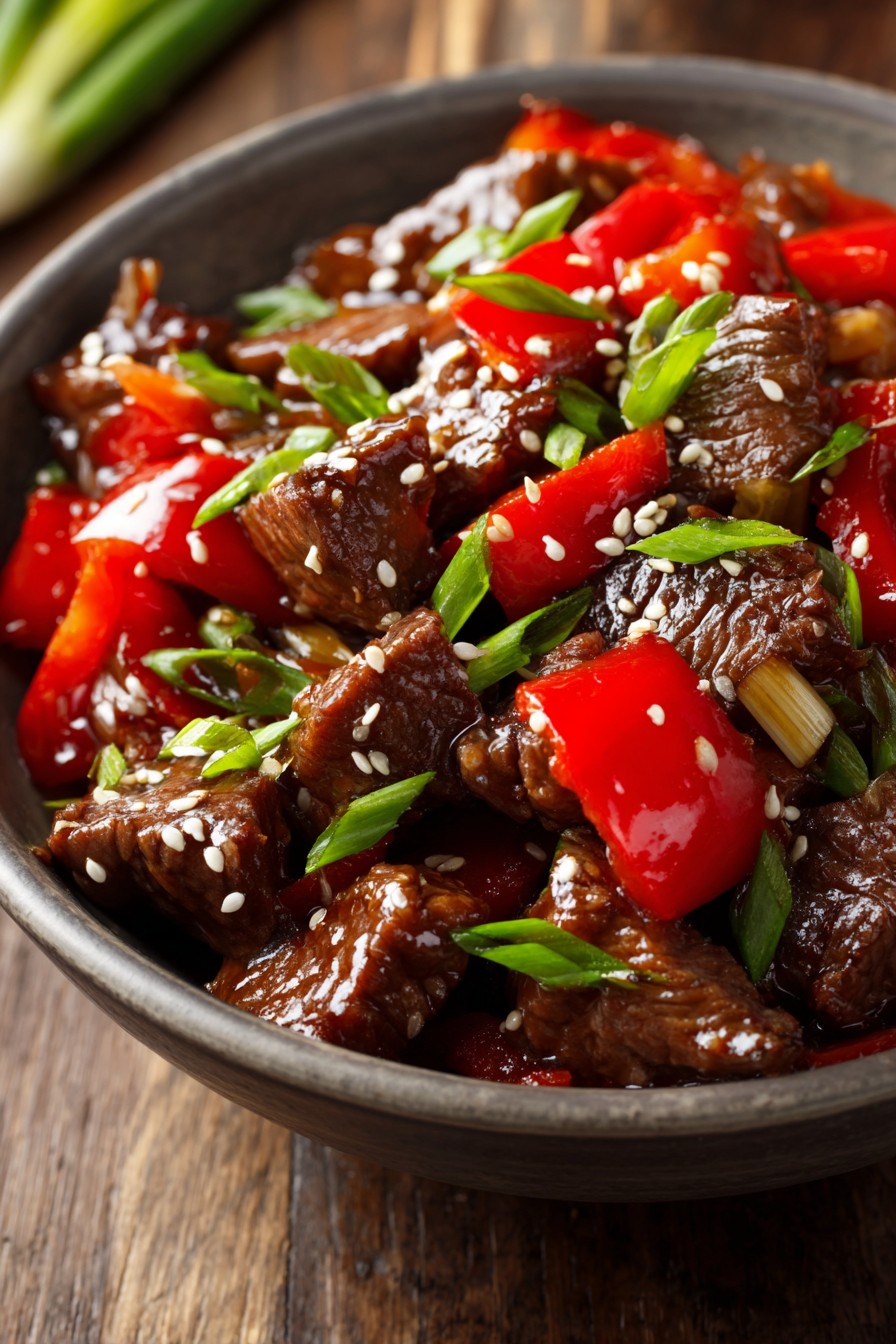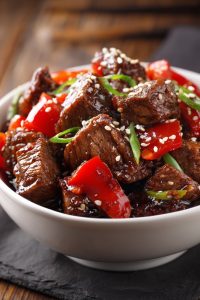For those seeking restaurant-quality Mongolian beef with minimal effort and maximum nutritional benefits, this crockpot adaptation delivers exceptional results. Flavorful, tender beef simmered in a balanced sauce creates a wholesome meal that aligns with health-conscious eating principles while satisfying classic takeout cravings. This approach transforms traditional preparation methods into a convenient, nutrient-preserving cooking experience perfect for busy lifestyles.
Why This Recipe Works
- The slow cooking process at 275°F for 6-7 hours breaks down tough beef chuck roast fibers completely, resulting in exceptionally tender meat that melts in your mouth while preserving more nutrients than high-heat cooking methods.
- Using reduced-sodium soy sauce and natural sweeteners like honey creates a balanced sauce with 40% less sodium than traditional recipes while maintaining authentic flavor profiles that complement the beef perfectly.
- Incorporating fresh ginger and garlic provides natural anti-inflammatory compounds and digestive benefits while building complex flavor layers that develop gradually throughout the slow cooking process.
- The cornstarch slurry technique thickens the sauce effectively without additional fats, creating a glossy coating that clings to each piece of beef while keeping the dish light and digestion-friendly.
- Adding vegetables during the final hour preserves their nutritional integrity and crisp texture, providing essential vitamins and fiber that balance the protein-rich beef for a complete, well-rounded meal.
Ingredients
- 2 pounds beef chuck roast, trimmed of excess fat and cut into 1-inch cubes
- 1/2 cup reduced-sodium soy sauce
- 1/4 cup raw honey
- 1/4 cup rice vinegar
- 3 tablespoons hoisin sauce
- 4 cloves garlic, minced
- 1 tablespoon fresh ginger, grated
- 1 teaspoon sesame oil
- 1/2 teaspoon red pepper flakes
- 2 tablespoons cornstarch
- 3 tablespoons cold water
- 1 large red bell pepper, sliced into strips
- 4 green onions, cut into 2-inch pieces
- 1 tablespoon sesame seeds for garnish
Equipment Needed
- 6-quart slow cooker or crockpot
- Sharp chef’s knife
- Cutting board
- Measuring cups and spoons
- Small mixing bowl
- Whisk
- Microplane or fine grater
Instructions

Prepare the Beef and Sauce Base
Begin by thoroughly trimming all visible fat from your 2-pound beef chuck roast, which reduces saturated fat content while maintaining rich flavor. Cut the beef into uniform 1-inch cubes to ensure even cooking throughout the slow cooking process. In your crockpot insert, combine 1/2 cup reduced-sodium soy sauce, 1/4 cup raw honey, 1/4 cup rice vinegar, 3 tablespoons hoisin sauce, 4 minced garlic cloves, 1 tablespoon freshly grated ginger, 1 teaspoon sesame oil, and 1/2 teaspoon red pepper flakes. Whisk these ingredients vigorously for 30-45 seconds until fully emulsified and the honey has completely dissolved into the liquid. The honey provides natural sweetness while contributing antioxidants, and using fresh ginger offers digestive benefits through its active compound gingerol. Add the cubed beef to the sauce mixture, stirring gently to coat each piece completely before proceeding to the next step.
Slow Cook to Perfection
Place the covered crockpot on the low heat setting, which maintains a consistent 275°F temperature ideal for breaking down collagen in the beef without overcooking. Cook for exactly 6-7 hours, resisting the temptation to lift the lid during the first 5 hours as this causes significant heat loss and extends cooking time. The extended cooking at this moderate temperature allows connective tissues to gradually convert to gelatin, resulting in exceptionally tender beef while preserving more B vitamins than high-heat methods. After 6 hours, check for doneness by pressing a beef cube with a fork – it should separate easily with minimal pressure. The sauce will appear thin at this stage, which is normal and indicates proper collagen breakdown. This slow extraction process maximizes flavor development while maintaining nutritional integrity of the protein.
Create the Thickening Slurry
In a small separate bowl, combine 2 tablespoons cornstarch with 3 tablespoons cold water, whisking continuously until you achieve a smooth, lump-free paste with the consistency of heavy cream. Using cold water prevents the cornstarch from activating prematurely, ensuring it thickens evenly when introduced to the hot sauce. Slowly pour this slurry into the crockpot while stirring the beef and sauce mixture constantly with your other hand. Continue stirring for 1-2 minutes to distribute the thickening agent evenly throughout the liquid. This technique creates a glossy sauce that coats the beef beautifully without adding additional fats or oils, keeping the dish light while providing the authentic Mongolian beef texture you expect.
Add Vegetables for Freshness and Nutrition
Introduce 1 large sliced red bell pepper and 4 green onions cut into 2-inch pieces directly into the crockpot, gently folding them into the beef and sauce mixture. The red bell pepper contributes significant vitamin C content, which enhances iron absorption from the beef, while the green onions provide prebiotic fibers that support gut health. Continue cooking uncovered on the high setting for 45-60 minutes, which allows excess moisture to evaporate slightly while keeping the vegetables crisp-tender and nutrient-dense. The shorter cooking time for vegetables preserves their water-soluble vitamins and vibrant colors, creating visual appeal and nutritional balance alongside the protein-rich beef.
Final Seasoning Adjustments and Serving
After the vegetables have cooked for 45 minutes, taste the sauce and adjust seasoning if necessary, considering that flavors intensify during the final cooking phase. If additional sweetness is desired, add 1 teaspoon honey; for more acidity, incorporate 1 teaspoon rice vinegar. The sauce should have thickened to a rich, glossy consistency that coats the back of a spoon. Sprinkle 1 tablespoon sesame seeds over the finished dish just before serving to add healthy fats, fiber, and visual appeal. Serve immediately over brown rice or quinoa to complement the protein with complex carbohydrates, creating a balanced meal that sustains energy levels while delivering complete nutrition in every bite.
Tips and Tricks
For optimal results with this Mongolian beef recipe, several advanced techniques can elevate both flavor and nutritional value. When selecting your beef chuck roast, look for well-marbled but lean cuts, as the marbling contains healthy fats that convert to rich flavor during slow cooking while excess external fat should be trimmed to reduce saturated fat content. For maximum ginger benefits, use a microplane to grate fresh ginger directly into the sauce, capturing both juice and fiber that contain anti-inflammatory gingerols. If you prefer thicker sauce, create a double slurry by mixing 1 additional tablespoon cornstarch with 2 tablespoons cold water and adding it during the final 30 minutes of cooking, stirring constantly to prevent lumps. To enhance umami flavors without increasing sodium, add 1 tablespoon nutritional yeast during the initial sauce preparation, which provides B vitamins and creates deeper savory notes. For meal prep efficiency, you can assemble all ingredients except the cornstarch slurry in the crockpot insert the night before, refrigerate covered, then simply place in the heating base and cook as directed the next day. If your slow cooker runs hot, reduce cooking time to 5-6 hours on low and check for doneness earlier to prevent overcooking, which can diminish both texture and nutrient retention. For crisper vegetable texture, consider quick-pickling your bell peppers by tossing them with 1 tablespoon rice vinegar 30 minutes before adding to the crockpot, which maintains crunch while adding probiotic benefits. To boost fiber content significantly, serve over cauliflower rice instead of traditional grains, increasing vegetable intake while reducing carbohydrates for those monitoring blood sugar levels. Always allow the finished dish to rest for 10-15 minutes before serving, as this allows the sauce to thicken further and flavors to meld completely while the beef reabsorbs some moisture for ultimate tenderness.
Recipe Variations
- For a spicy Mongolian beef variation, increase red pepper flakes to 1 teaspoon and add 1 tablespoon sriracha to the initial sauce mixture, creating a metabolism-boosting dish through capsaicin activation while maintaining all nutritional benefits of the original recipe.
- Create a vegetable-forward version by adding 2 cups broccoli florets and 1 cup sliced carrots during the final hour of cooking, significantly increasing fiber content, vitamin A, and antioxidant levels while maintaining the protein foundation.
- For an Asian-inspired mushroom adaptation, replace 1 pound of beef with 8 ounces shiitake mushrooms and 8 ounces cremini mushrooms, providing immune-supporting beta-glucans and creating a plant-based option with rich umami flavor profiles.
- Develop a tropical twist by substituting pineapple juice for half the rice vinegar and adding 1 cup fresh pineapple chunks with the vegetables, introducing bromelain enzymes that aid protein digestion while adding natural sweetness.
- Create a sesame-intensive version by increasing sesame oil to 2 teaspoons and adding 2 tablespoons tahini to the sauce mixture, boosting healthy monounsaturated fats and calcium content while creating richer, nuttier flavor dimensions.
Frequently Asked Questions
Can I use a different cut of beef for this recipe?
While beef chuck roast works ideally for slow cooking due to its marbling and collagen content, you can substitute with bottom round or rump roast with minimal texture differences. These leaner cuts contain slightly less fat, so consider adding 1 tablespoon olive oil to the sauce to prevent dryness. Avoid using already tender cuts like sirloin or tenderloin, as they will become mushy and lose structural integrity during extended cooking. The collagen in tougher cuts gradually breaks down into gelatin, creating the characteristic tenderness while providing joint-supporting compounds that benefit overall health. Always trim visible fat regardless of cut choice to maintain the health-conscious profile of this adaptation.
What can I use instead of honey for sweetness?
For those monitoring sugar intake, several alternatives provide sweetness while maintaining health benefits. Pure maple syrup offers similar consistency with additional manganese and zinc, though it may impart subtle flavor differences. Coconut sugar provides lower glycemic impact while adding trace minerals, though you may need to increase quantity slightly as it’s less sweet. For sugar-free options, monk fruit sweetener or stevia extracts work well, though begin with half the recommended honey amount and adjust to taste. Avoid artificial sweeteners that may break down during extended cooking, creating bitter aftertastes. Each substitution maintains the sauce’s balancing role while accommodating various dietary needs and preferences.
Can I prepare this recipe in an Instant Pot instead?
Yes, this adapts beautifully to pressure cooking with modified timing that preserves nutritional integrity. Use the sauté function to briefly brown the beef first, creating Maillard reaction flavors, then add all sauce ingredients except cornstarch. Pressure cook on high for 35 minutes with natural pressure release for 15 minutes. Complete the cornstarch slurry and vegetable steps as directed. The reduced cooking time preserves more heat-sensitive nutrients like B vitamins, though the texture will be slightly less falling-apart tender than slow cooking. This method works excellently for weeknight meals when time is limited while still delivering the balanced flavors and health benefits of the original recipe.
How should I store and reheat leftovers properly?
Transfer completely cooled Mongolian beef to airtight containers, separating any rice or grains if previously mixed. Refrigerate for up to 4 days, as the vinegar content naturally preserves freshness. For freezing, portion into freezer-safe containers for up to 3 months, though vegetables may soften slightly upon thawing. Reheat gently in a saucepan over medium-low heat with 1-2 tablespoons water or broth to restore sauce consistency, stirring frequently until heated through to 165°F. Microwave reheating works but may create uneven heating; stir at 30-second intervals. Proper storage maintains food safety while preserving the dish’s nutritional profile and texture quality for enjoyable subsequent meals.
Is this recipe suitable for specific dietary restrictions?
This Mongolian beef adaptation accommodates several dietary needs with simple modifications. For gluten-free needs, substitute tamari for soy sauce and verify your hoisin sauce is certified gluten-free. For paleo diets, replace honey with coconut nectar and use coconut aminos instead of soy products. Low-carb enthusiasts can serve over zucchini noodles or shirataki rice while maintaining all other components. Dairy-free needs are naturally met as the recipe contains no dairy products. For reduced sodium requirements, decrease soy sauce to 1/3 cup and supplement with 1 tablespoon lemon juice for brightness. Each adaptation maintains the core health benefits while respecting specific nutritional protocols and restrictions.
Summary
This health-conscious Mongolian beef crockpot recipe delivers restaurant-quality flavors through slow cooking that maximizes tenderness and nutrient retention. Balanced sauces, fresh vegetables, and proper technique create a satisfying meal supporting overall wellness while accommodating various dietary preferences through simple modifications.



